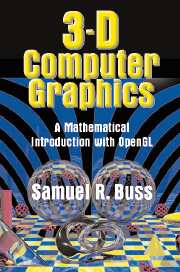Book contents
- Frontmatter
- Contents
- Preface
- I Introduction
- II Transformations and Viewing
- III Lighting, Illumination, and Shading
- IV Averaging and Interpolation
- V Texture Mapping
- VI Color
- VII Bézier Curves
- VIII B-Splines
- IX Ray Tracing
- X Intersection Testing
- XI Radiosity
- XII Animation and Kinematics
- A Mathematics Background
- B RayTrace Software Package
- Bibliography
- Index
- Plate section
VII - Bézier Curves
Published online by Cambridge University Press: 05 June 2012
- Frontmatter
- Contents
- Preface
- I Introduction
- II Transformations and Viewing
- III Lighting, Illumination, and Shading
- IV Averaging and Interpolation
- V Texture Mapping
- VI Color
- VII Bézier Curves
- VIII B-Splines
- IX Ray Tracing
- X Intersection Testing
- XI Radiosity
- XII Animation and Kinematics
- A Mathematics Background
- B RayTrace Software Package
- Bibliography
- Index
- Plate section
Summary
A spline curve is a smooth curve specified succinctly in terms of a few points. These two aspects of splines, that they are smooth and that they are specified succinctly in terms of only a few points, are both important. First, the ability to specify a curve with only a few points reduces storage requirements. In addition, it facilitates the computer-aided design of curves and surfaces because the designer or artist can control an entire curve by varying only a few points. Second, the commonly used methods for generating splines give curves with good smoothness properties and without undesired oscillations. Furthermore, these splines also allow for isolated points where the curve is not smooth, such as points where the spline has a “corner.” A third important property of splines is that there are simple algorithms for finding points on the spline curve or surface and simple criteria for deciding how finely a spline must be approximated by linear segments to obtain a sufficiently faithful representation of the spline. The main classes of splines discussed in this book are the Bézier curves and the B-spline curves. Bézier curves and patches are covered in this chapter, and B-splines in the next chapter.
Historically, splines were specified mechanically by systems such as flexible strips of wood or metal that were tied into position to record a desired curve. These mechanical systems were awkward and difficult to work with, and they could not be used to give a permanent, reproducible description of a curve.
- Type
- Chapter
- Information
- 3D Computer GraphicsA Mathematical Introduction with OpenGL, pp. 155 - 199Publisher: Cambridge University PressPrint publication year: 2003



